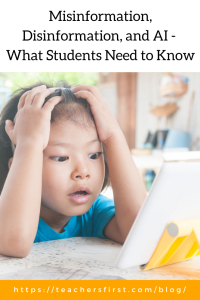Artificial intelligence (AI) is an amazing tool. Like all tools, it has benefits and deficits—one deficit affecting education is AI’s ability to produce misinformation and disinformation. Misinformation is false or inaccurate information, and disinformation is false information deliberately produced to mislead. Media literacy education is key to teaching students to recognize misinformation and disinformation produced by AI. For the purposes of this blog post, we will use the term misinformation to address both misinformation and disinformation.
AI-generated content is escalating. Teaching students to recognize and counter misinformation in this age of AI is no easy task, but it is necessary. Knowing what to trust is the first step, and there are a variety of resources available to help students at all grade levels think critically about information and its sources. Encourage young elementary students to be deceptive detectives. Teach older students to evaluate media with the Rumor Guard 5 Factors or something similar. The News Literacy Project’s Resource Library contains everything you need to start teaching students in grades 4–12 how to evaluate media, including lesson plans, classroom activities, infographics, and quizzes. Teach your students to evaluate media using reverse image search, lateral reading, and critical observation. Provide them with advice and resources that will help them recognize and avoid being fooled by AI-generated content, like PBS Media’s Navigating Artificial Intelligence lesson for grades 6–12. Engage them with real-world examples and activities. Test their AI IQ, see if they can tell the difference between real life people and AI generated people, or put this activity on a white board and have students test their deep fake detection skills. Engage them in a debate surrounding Meta and AI, whether AI is a threat to democracy, or the ethics of generative AI.
Start helping your students think critically about AI, media, and misinformation now, and check out TeachersFirst’s reviewed resources and blog posts for more tools and content related to misinformation and media literacy.



It is crucial to consider that AI is an amazing tool, but there should be some caution. AI can produce misinformation and disinformation, therefore it is important to use your own judgment. Students should be educated on media literacy, specifically on how to recognize whether to trust content produced by AI.